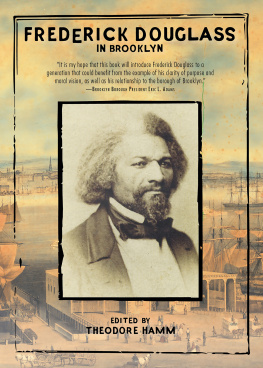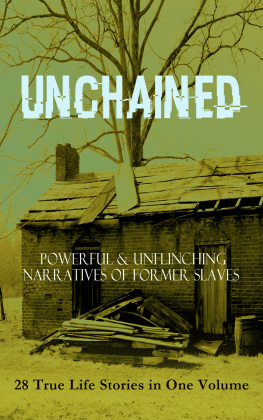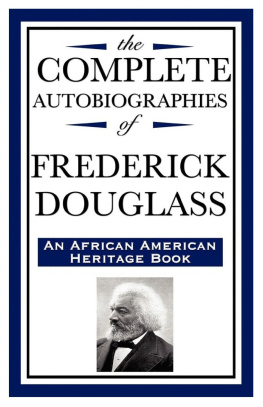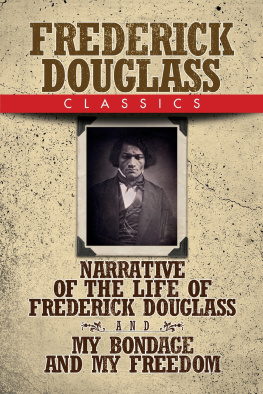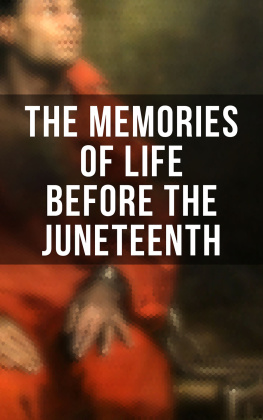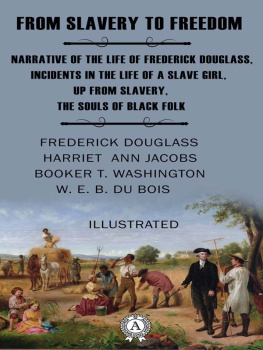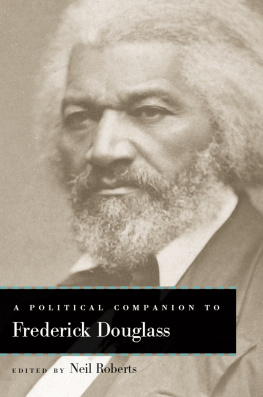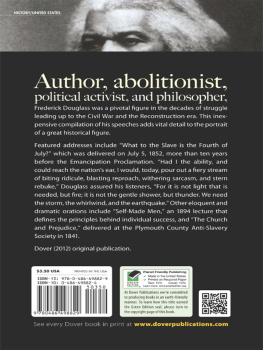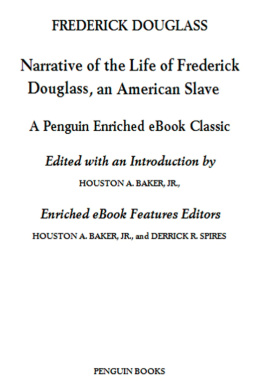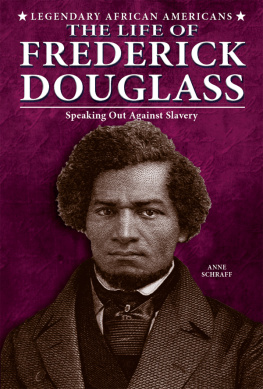
For Toni and Ellis
Frederick Douglass, a man born in bondage and committed to the freedom of his people, arrived in Brooklyn to share a message of equality at institutions we know today, such as Bridge Street African Methodist Episcopal Church in Bedford-Stuyvesant and Plymouth Church in Brooklyn Heights. His descriptions of the evils of slavery resounded in the ears of listeners, and his speeches inspired their work as abolitionists. We continue to honor his legacy with three Frederick Douglass Academy schools in Brooklyn. It is my hope that this book will introduce Mr. Douglass to a generation that could benefit from the example of his clarity of purpose and moral vision, as well as his relationship to the Borough of Brooklyn.
Brooklyn Borough President Eric L. Adams
Introduction
Mr. Douglass has been in the habit of carrying his audiences by storm. His peculiar wit, sarcasm, drollery, dramatic intensity, and, more than all, his noble moral earnestness, set in strong relief by an indefinable and touching sadness of tone and mien, [are] apparent [in] all his speeches. Though he makes his listeners alternately cheer, laugh, and weep, they inevitably carry away with them, as the chief impression of the evening, not the ornament or side-play, but the logical frame-work and solid sense of the discourse. Frederick Douglass, beginning his life as a bond-slave, will leave behind him an honest fame as one of the chief orators of his day and generation.
Brooklyns Theodore Tilton, Independent,
February 12, 1863
Upon Frederick Douglasss death in 1895, the New York Tribunea newspaper founded by a leading abolitionist, Horace Greeleydug up a chestnut from a half-century earlier. In 1846, Douglass had delivered a speech at a temperance gathering in Londons Covent Garden Theatre. There he told an audience that included both British royalty and US ministers that while temperance was indeed a worthy cause, the abolition of slavery was more important. After Douglasss address, the Tribune said, among those who sought to congratulate the speaker was an eminent Brooklyn divine. Never one to mince words, Douglass rejected the overture. He told the minister, Sir, were we to have met under similar circumstances in Brooklyn, you would never have ventured to take my hand, and you shall not do it here.
Beyond illustrating Douglasss resolute character, the anecdote also yields insight into Brooklyns race relations in the decades before the Civil War. Despite the presence of prominent white abolitionists, as well as that of vocal African Americans, Brooklyn was far from a haven of black equality. In the wake of the London meeting, Douglass engaged in a high-profile war of words in print with Reverend Samuel Hanson Cox, the prominent pastor of Brooklyns First Presbyterian Church. Though an abolitionist, Cox was outraged that Douglass had raised the issue of slavery at the temperance convention. In the New York Evangelist, a Presbyterian weekly newspaper, Cox called Douglasss actions a perversion of the meetings intent and abominable! In William Lloyd Garrisons Liberator, an influential abolitionist paper from Boston, Douglass labeled Cox a sham opponent of slavery. Audiences across the Northeast thus became aware of Brooklyns contested racial terrain.
Frederick Douglass never lived in Brooklyn, but his visits to the City of Churches stirred both enthusiasm and controversy. During the Civil War era many of his key friends and alliesincluding Henry Ward Beecher, Theodore Tilton, Lewis Tappan, James and Elizabeth Gloucester, James McCune Smith, and William J. Wilson (a.k.a. Ethiop)called Brooklyn home. Douglass had close ties to three publications with Brooklyn roots: the Rams Horn (18471849), the Anglo-African (18591865), and the Independent (1860s). Meanwhile, his own publications, the North Star and Frederick Douglass Paper, featured regular Brooklyn correspondents, most notably Ethiop. Douglass was a close friend of John Brown, and the pages of the Anglo-African noted the formers stop in Brooklynat the home of Elizabeth Gloucesteren route to a pivotal Harpers Ferry planning meeting in late August 1859. Theodore Tilton, who rose to prominence in his defense of Brown in the Independent, would become one of Douglasss closest confidants during the Civil War and Reconstruction.
Both in person and print, Douglass was a powerful presence in Brooklynand the varied reactions to his positions on abolition and black equality thus illustrate the ways in which those issues shaped the city in its formative decades. At African American churches like Reverend James N. Gloucesters Siloam Presbyterian or James Morris Williamss Bridge Street AME, or at white abolitionist strongholds like Henry Ward Beechers Plymouth Church, the gifted orator received a heros welcome. But in the pages of the Brooklyn Daily Eagle, a conservative Democratic organ during the Civil War, Douglass was often subjected to racist ridicule. Douglass had garnered a more friendly reception from Walt Whitman, during the latters short stints as editor of both the Eagle and the Brooklyn Daily Times. Even so, Whitmans position on racial issuesantislavery but not proequalityreflected a notable current of local sentiment. Like New York City, Brooklyn (its own city until 1898) had strong economic ties to Southern slavery, making the place a racial minefield. But with the help of his steadfast allies, Douglass navigated it safely.
* * *
Twenty-year-old Frederick Bailey first became acquainted with New York abolitionists in September 1838. Born a slave on the Eastern Shore of Maryland around February 1818, Bailey came of age in Baltimore, where he learned to read and soon inspired his peers to do the same; after a few unsuccessful attempts to escape, he fled safely to New York via trains and ferries while carrying the identification papers of a free black seaman. Once in Manhattan, Bailey sought out David Ruggles, a leading African American conductor of the Underground Railroad. He informed Ruggles of his desire to marry his fiance, Anna Murray, who would soon join him in New York; soon thereafter, Reverend James W.C. Pennington came from Brooklyn to perform the wedding at Ruggless home on Lispenard Street. (Thus began a long alliance between the soon-to-be Douglass and Penningtonwho would preside over Shiloh Presbyterian, an abolitionist stronghold on Prince Street in Manhattan.) From New York, Frederick and Anna traveled via boat to Newport, Rhode Island, then by stagecoach to New Bedford, Massachusetts, where they set up shop and became the Douglass family. In the summer of 1841, Douglass first met William Lloyd Garrison, who helped launch his career as a public figure. That fall, the family moved to Lynn, Massachusetts, and it was there that Douglass wrote the book that would build his international reputation, Narrative of the Life of Frederick Douglass, an American Slave, which Garrisons American Anti-Slavery Society published in 1845.
Brooklyn was far from a bastion of abolitionist support in the mid-1840s. Many early Kings County residents had owned slaves, and after Brooklyn officially became a city in 1834, local merchants competed with their counterparts across the East River for the trade in Southern products. Indeed, so widespread was the support for slavery in Brooklyn that in 1839 David Ruggles called the city the Savannah of New York. Beginning in May 1842, Douglass spoke at the annual meetings of the Garrison-led American Anti-Slavery Society in Manhattan, which usually took place at the Broadway Tabernacle, the church where the Tappan brothers held sway. Beyond abolitionist circles, Douglass was not a household name in the New York area until his autobiography came outand even then Brooklyn audiences more likely read about him in Horace Greeleys
Next page
